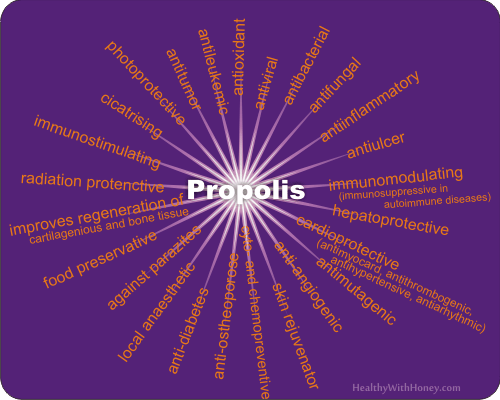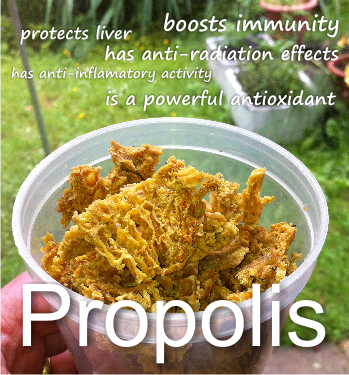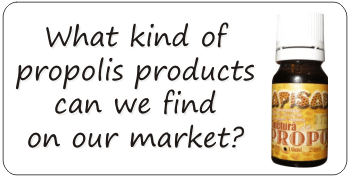Grosso modo, propolis is like a honey essence. It has lots of phytocompounds, without sugars. That’s even better, you would say, and from a therapeutic point of view, it’s true. And yes, propolis protects your liver while drinking.
The only downside is that you won’t eat propolis for pleasure, as you do with honey.
It comes in different forms, with different concentrations and powers, from tablets and creams, to pure essence.
And when we compare propolis to honey, as I said in other posts, propolis is more curative, while honey is more preventative.
Here is a very recent study which unveils one important feature of propolis: its capacity to prevent liver damage. That’s good news for alcohol lovers. Because liver is the primary organ for the metabolism of alcohol, which makes it the major target of alcohol-induced injury.
The study “Alterations in the Transcriptional Profile of the Liver Tissue and the Therapeutic Effects of Propolis Extracts in Alcohol-induced Steatosis in Rats” was conducted by MANHONG YE from College of Bioscience and Biotechnology, Yangzhou University, China, and was published in 2019. It investigated the hepatoprotective effects of ethanolic extracts of propolis (EEP) on alcohol-induced liver steatosis.
Liver steatosis, aka fatty liver, is an accumulation of fat in the liver. Too much fat can cause liver inflammation, which can damage the liver and create scarring (known as liver fibrosis). Severe liver fibrosis, is known as cirrhosis, which is a potentially life-threatening condition.
When fatty liver develops in someone who drinks a lot of alcohol, it’s known as alcoholic fatty liver disease (AFLD). There is also non-alcoholic fatty liver disease (NAFLD), in people who don’r drink much alcohol, up to 25% to 30% of people in the United States and Europe.
The researchers in the above mentioned study used Wistar rats and induced chronic alcoholic fatty liver by administration of 52% alcohol at the dose of 1% body weight, for 7 weeks.
The animals were then simultaneously treated with:
a) 50% ethanolic extracts of propolis (funny to treat an alcohol induced disease with other form of alcohol) or
b) normal saline at the dose of 0.1% body weight, for 4 further weeks.
The results from microarray confirmed that 4-week co-administration of propolis with alcohol significantly down-regulated the expressions of well-known SREBP-1 (Sterol Regulatory Element-binding Protein-1) responsive lipogenic genes, FASN (fatty acid synthase), SCD1 (stearoyl-CoA desaturase 1), and FABP5 (fatty acid binding protein 5), which might be helpful in preventing the hepatic lipid accumulation.
The hepatic expressions of genes involved in lipogenesis were significantly down-regulated by the ethanolic extracts of propolis treatment, while the transcriptional expressions of functional genes participating in fatty acids oxidation were markedly increased.
Propolis treatment inactivated not only genes directly responsible for FAs (fatty acids) synthesis, but also genes responsible for the production of the two-carbon unit (acetyl-CoA) required for FA synthesis, which was effective in inhibiting lipogenesis and ameliorating lipid accumulation in the liver.
Propolis also stimulated the expression of genes participated in FA oxidation, which included Acot1 and Acot4. Localized in the cytosol (Acot1) and peroxisome (Acot4), these two enzymes play important roles in FA metabolism. And the enhanced FA oxidation is an important step for the reversal of fat accumulation in the liver tissue.
After the 4-week treatment, the ethanolic extracts of propolis helped in restoring the levels of various blood indices, liver function enzymes and the histopathology of liver tissue, to normal levels.
The results showed that the ethanolic extract of propolis has the ability to reduce the negative effects of alcohol alcoholic fatty liver.
Alcohol-elicited fatty liver is the initial and reversible stage of AFLD (Alcohol-induced fatty liver disease) and the patient needs to find the right nutritional and/or pharmacological agents, that can alleviate hepatic lipid accumulation and decrease susceptibility of the liver to more advanced forms of liver injuries. The success of this study recommends ethanolic propolis extract as a trustful natural product for the alternative treatment of alcoholic fatty liver. Its beneficial roles were attributed to its high flavonoid content.
What is ethanolic extract of propolis (EEP)?
The ethanolic extract used in the study was produced from 100 g raw propolis, which produced approximately 25 g of dry EEP (a yield of approximately 25%). (also see How to make propolis tincture)
Spectrophotometric analysis showed that EEP was rich in flavonoids and the total flavonoids content of EEP was averagely 204.5 mg RE per g of dry EEP.
The GC-MS analysis of EEP identified 24 chemical compounds mainly including flavonoids (19.02%), esters of aliphatic and aromatic acids (14.02%), and alcohols (8.21%). Of which, chrysin, galangin, pinocembrine, naringin, tectochrysin and pinostrobin are the main flavanoids in EEP.
The others include: 1(5)-Guaien-11-ol, Beta-Eudesmol , Bulnesol, Hanamyol, Alpha-Bisabolol, Ethyl tetradecanoate/Ethyl myristate, 2-Naphthalenemethanol, Cryptomeridiol, Ethyl palmitate, Elaidic acid, ethyl ester, Stearic acid, ethyl ester, 9-Hexadecenoic acid, ethyl ester, Trans-Ferulic acid, 9-Hexadecenoic acid, eicosyl ester, Cinnamyl cinnamate, Benzyl (E)-3-(4-hydroxyphenyl) acrylate.
See more on Composition of propolis
Pinocembrin has been reported to prevent thioacetamide (TAA)-induced liver cirrhosis (Chen et al. 2008, study). Studies, both in vivo (Zhou et al. 2018) and in vitro (Said et al. 2018), demonstrated its potent anti-fibrotic effects.
Naringin has been reported to have anti-fibrotic efficacy in TAA-induced hepatic fibrosis in rats (El-Mihi et al. 2017), exert protective effects against chemicals-induced hepatoxicity (Pari and Amudha 2011), alleviate the adverse effects of ethanol ingestion in rats by increasing ethanol and lipid metabolism (Seo et al. 2003). In the intragastric fed rat model of ALD, naringin also showed such beneficial influences as inhibition of steatosis, necrosis, and fibrosis (Oliva et al. 2008).
Chrysin (5,7-dihydroxyflavone) is a naturally occurring flavonoid present at high levels in honey, propolis and numerous plant extracts (passionflower, silver linden, and some geranium species). It has global hepatoprotective effects, including preventing oxidative damage due to chronic ethanol consumption (Tahir and Sultana, 2011), reducing ethanol-induced liver injury (Sathiavelu et al. 2009), ameliorating CCl4-induced acute liver damage by counteracting the activation of inflammation signaling pathways (Hermenean et al. 2017), and alleviating hepatic injury caused by administration of cisplatin (Rehman et al. 2014).
Its anti-fibrotic effect on regression of CCl4-stimulated liver fibrosis was also recently documented (Balta et al. 2015, 2018).
Galangin, present in propolis and Alpinia officinarum Hance (also known as lesser galangal, a plant in the ginger family), could suppress the proliferation of hepatocellular carcinoma cells (Wang et al. 2014, 2017), ameliorate concanavalin A-induced liver damage in mice (Luo et al. 2015), provide hepatoprotective effects in acetaminophen-treated mice by decreasing the hepatic oxidative stress and increasing hepatic glutathione level (Tsai et al. 2015). In a CCl4-induced rat liver fibrosis model, galangin exerted anti-fibrotic effects (Wang et al. 2013). The anti-adipogenic activity of galangin was also documented (Jung et al. 2012).
What propolis is the best?
That’s a question I often receive. Unfortunately, there is no scientific study that can identify the best available propolis on the market. 🙂 Ads are subjective, reviews are often paid and there are too many forms to choose from.
We usually take price as a major criteria in selecting a product. A medium price would probably be the best, right? Because if it’s too cheap it means it’s of low quality. If the price is high it means we pay either the brand, or their greed.
On Amazon one can find all the types. I personally recommend NaturaNectar, and their various forms of propolis, but unfortunately they don’t sell worldwide. Which is why Now Foods is preferred by most of us. (#ad)
Whatever you choose, keep in mind that what you see on the front label (eg. propolis 1500) is not the real quantity of propolis extract found in a tablet (300mg, in our example from One Foods).
Related articles:
Alcohol detoxification with honey
Propolis prevents and treats aluminum toxicity. Remember this and minimize the exposure.
Brazilian Green Propolis health benefits
Propolis can prevent and treat LEUKEMIA and CANCER
If it looks like propolis is the answer to everything, well, it almost is. Studies are continually discovering its amazing health benefits and we can read its name on all sorts of products, from toothpaste to skin creams. Here is a picture which gathers some of its scientifically proved properties:







